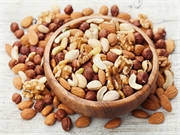Most peanut-allergic individuals could tolerate tree nuts, but many avoid them
MONDAY, Dec. 30, 2019 (HealthDay News) — Individual tree nuts have unique characteristics in the context of peanut allergy, so dietary recommendations should reflect these differences, according to a study published online Dec. 2 in the Annals of Allergy, Asthma & Immunology.
S. Shahzad Mustafa, M.D., from Rochester Regional Health in New York, and colleagues used data from 258 individuals with a physician’s diagnosis of peanut allergy (median age at time of study enrollment, 6 years) seen in an outpatient allergy practice during January 2019 through April 2019. Patients with a clinical history suggestive of immunoglobulin E-mediated peanut allergy underwent skin prick testing and/or measurement of serum immunoglobulin E. Individuals, who despite this testing had an uncertain peanut allergy, underwent a medically supervised unblinded oral food challenge (OFC).
The researchers found that rates of sensitization for various tree nuts ranged from 43 to 54.3 percent. Of the 258 peanut-allergic individuals, 36.8 percent consumed all tree nuts ad lib in their diet; 24.4 percent consumed some, but not all, tree nuts; and 38.8 percent consumed no tree nuts. Of those avoiding all tree nuts, half reported it was due to perceived risk for cross contact, 16 percent reported no desire to consume any tree nuts, 13 percent were avoiding due to young age, and 12 percent were avoiding all tree nuts due to a high likelihood of being allergic (e.g., based on previous clinical reactivity). Nearly three-quarters of peanut-allergic patients (73.3 percent) were advised to consume almonds at home, with an additional 15.9 percent being offered OFCs. Two-thirds of patients were also counseled that introduction of hazelnut would be safe, with 15.9 percent also being offered OFCs. Pecan and walnut were also frequently offered in the diet of more than three-quarters of peanut-allergic individuals. Despite cashews and pistachios having the highest rate of potential co-allergy, more than half of peanut-allergic individuals (60 percent) were still offered home or office introduction of these tree nuts.
“Our data indicated that avoiding foods with PAL [precautionary allergen labeling] may have an overly restrictive impact on the diet of people with peanut allergy,” Mustafa said in a statement. “Eating foods with PAL is something people with food allergies should discuss with their allergist and take into consideration when creating their diet.”
One author disclosed financial ties to the biotechnology and pharmaceutical industries.
Copyright © 2019 HealthDay. All rights reserved.








